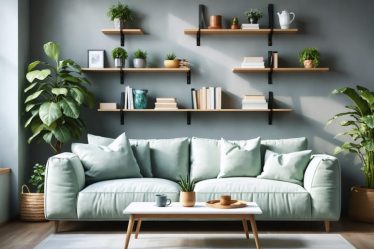
Transform any room into a lush oasis with the ZZ plant (Zamioculcas zamiifolia), one of the most resilient and beautiful indoor plants you can grow. This striking African native, with its glossy emerald leaves and sculptural stems, thrives in spaces where other houseplants struggle. Perfect for busy plant parents and first-time growers, ZZ plants survive low light conditions, irregular watering, and fluctuating temperatures while purifying your air and adding sophisticated style to any corner. Whether tucked in a dim office corner or displayed as a statement piece in your living room, this low-maintenance marvel consistently delivers dramatic impact with minimal effort. Its ability to adapt to various indoor environments, combined with its modern, architectural appearance, makes the ZZ plant an essential addition to any contemporary home or workspace.
Why ZZ Plants Are Perfect for Modern Homes
Sleek, Modern Aesthetic
The ZZ plant’s glossy, dark green leaves and naturally sculptural form make it a perfect match for modern interior design. Its clean lines and symmetrical growth pattern create an architectural statement that feels right at home in contemporary spaces. I’ve seen these beauties transform everything from minimalist Scandinavian-inspired living rooms to sleek office spaces with their sophisticated presence.
What I particularly love about ZZ plants is how their emerald-black foliage adds depth and drama without overwhelming a space. The stems grow in elegant arches, creating natural layers that catch the light beautifully. Whether styled on a floating shelf against a white wall or nestled in a matte black pot on a coffee table, these plants effortlessly elevate any room’s aesthetic while maintaining that coveted low-maintenance appeal that busy modern lives demand.

Practically Indestructible
If you’re a self-proclaimed plant killer looking for redemption, the ZZ plant might just be your saving grace. I remember bringing home my first ZZ during a particularly chaotic time in my life, and despite weeks of neglect, it not only survived but thrived! These remarkable plants have earned their reputation as practically indestructible, and it’s not just hype.
Native to drought-prone areas of Eastern Africa, ZZ plants have evolved to be incredibly resilient. They store water in their thick rhizomes (those potato-like structures under the soil), allowing them to survive weeks without watering. They’re equally unfussy about light conditions, happily growing in everything from bright indirect light to low-light office corners.
What truly makes them a superstar in the world of houseplants is their ability to withstand common plant parent mistakes. Forgot to water for a month? No problem. Stuck them in a dark corner? They’ll manage. Even temperature fluctuations and low humidity levels don’t faze these tough cookies. It’s no wonder they’ve become the go-to choice for busy professionals and self-proclaimed “black thumbs” alike.
Essential ZZ Plant Care Tips
Light and Location
One of the best things about ZZ plants is their incredible adaptability to various lighting conditions – trust me, I’ve had mine thriving in spots that made other plants throw tantrums! While they can tolerate low light environments (making them perfect for those darker corners of your home), they’ll grow best in bright, indirect light.
I learned the hard way that direct sunlight can be too harsh for these tropical beauties, potentially scorching their glossy leaves. The sweet spot? Place your ZZ plant about 3-6 feet away from an east or north-facing window. This gives them just the right amount of gentle light to maintain their gorgeous, emerald-green foliage.
Don’t worry if you only have a dim corner available – ZZ plants are incredibly forgiving. They’ll survive in offices with fluorescent lighting or rooms with minimal natural light. Just keep in mind that growth might be slower in these conditions. My favorite spot for a ZZ plant is in my home office, where it gets moderate light and makes for the perfect low-maintenance desk companion.
Remember to rotate your plant every few weeks to ensure all sides receive equal light exposure, keeping that classic symmetrical growth we all love about ZZ plants.
Watering Without Worry
Let me share a little secret about ZZ plants that made me fall in love with them – they’re incredibly forgiving when it comes to watering! As someone who once struggled with overwatering nearly every houseplant I owned, discovering the ZZ plant’s laid-back watering needs was a game-changer.
The golden rule with ZZ plants is less is more. Think of them as the camels of the plant world – they store water in their thick rhizomes and can handle periods of drought like champs. I typically water mine only when the soil is completely dry, which usually means every 2-3 weeks in summer and even less frequently in winter.
Here’s my foolproof watering method: stick your finger about two inches into the soil. If it’s still moist, wait a few more days. When it feels dry, that’s your cue to water thoroughly until you see it draining from the bottom holes. Just remember to empty that saucer afterward – nobody likes wet feet, especially not ZZ plants!
The biggest mistake I see fellow plant parents make is overwatering. Those thick, juicy stems can actually rot if they’re sitting in soggy soil. Yellow leaves are usually a sign you’re being too generous with the watering can. When in doubt, it’s always better to underwater than overwater these resilient beauties.

Soil and Feeding
One of the best things about ZZ plants is how low-maintenance they are when it comes to soil and feeding requirements. I learned this firsthand when I nearly killed mine with too much attention! These resilient plants thrive in well-draining potting mix – I recommend using a standard indoor potting soil mixed with extra perlite or orchid bark for better drainage.
When it comes to fertilizing, less is definitely more with ZZ plants. They’re not heavy feeders, which makes them perfect for busy plant parents or those of us who occasionally forget our green babies. A balanced, water-soluble houseplant fertilizer applied every 3-4 months during the growing season (spring and summer) is plenty. I typically dilute the fertilizer to half-strength just to be on the safe side.
Pro tip: If you notice your ZZ’s leaves turning yellow, it might actually be getting too much fertilizer rather than too little. These plants store nutrients in their thick rhizomes underground, making them surprisingly self-sufficient. When in doubt, err on the side of under-feeding rather than over-feeding.
Styling Your Space with ZZ Plants
Size and Container Selection
Choosing the right container for your ZZ plant is like finding the perfect home for your green friend! From my experience, these adaptable plants aren’t too picky about their living quarters, but a few smart choices can help them thrive and elevate your space beautifully.
Start with a pot that’s 1-2 inches larger than your plant’s root ball. ZZ plants actually prefer to be a bit snug in their containers – they’re not fans of swimming in excess soil! I learned this the hard way when I once planted mine in an oversized pot, only to find it wasn’t as happy as it could be.
For most homes, a 6-8 inch pot works perfectly for younger ZZ plants, while mature specimens might need containers up to 12 inches in diameter. Always ensure your chosen pot has drainage holes – this is non-negotiable for preventing root rot.
When it comes to materials, terra cotta pots are fantastic choices as they help regulate moisture levels naturally. However, if you’re like me and occasionally forget to water, plastic or ceramic containers might be better as they retain moisture longer.
Consider the visual impact too! For modern spaces, sleek white or black planters create a stunning contrast against the ZZ’s glossy leaves. In bohemian-inspired rooms, textured or natural-finish containers add that perfect touch of earthy charm.
Perfect Plant Pairings
Want to create a stunning indoor jungle? Your ZZ plant can be the perfect foundation for beautiful plant groupings that’ll make your space Instagram-worthy. As someone who loves experimenting with plant combinations, I’ve discovered some fantastic pairings that complement the ZZ plant’s striking appearance while following simple home decorating tips.
Snake plants make excellent companions, as their vertical growth pattern creates a beautiful contrast with the ZZ plant’s arching stems. Their similar care requirements make them perfect roommates! I love pairing my ZZ plant with pothos varieties – the trailing vines add a soft, cascading element that beautifully frames the ZZ’s structured form.
For a modern tropical vibe, try grouping your ZZ plant with a Chinese evergreen (Aglaonema). Their similar light requirements and complementary leaf patterns create an effortlessly chic display. Another winning combination is pairing ZZ plants with prayer plants (Maranta) – their burgundy undersides and patterned leaves add a pop of color while maintaining that low-maintenance appeal.
Remember to consider height variations when creating your groupings. Place taller ZZ plants behind shorter companions like peperomias, or use plant stands to create visual interest at different levels. The key is to mix textures and shapes while keeping care requirements similar – this ensures your plant family will thrive together beautifully.

As we’ve explored throughout this guide, the ZZ plant truly stands out as one of the most rewarding houseplants you can welcome into your home. Its striking appearance, incredible resilience, and minimal care requirements make it the perfect choice for both novice plant parents and seasoned enthusiasts alike.
Remember, the key to success with your ZZ plant lies in respecting its natural preferences: moderate watering, well-draining soil, and tolerance for various light conditions. These adaptable plants have taught me that sometimes the best care is minimal care – a valuable lesson for those of us who tend to hover over our green friends!
Whether you’re looking to add a touch of sophistication to your home office, create a statement piece in your living room, or simply start your plant parenthood journey, the ZZ plant won’t disappoint. Its glossy, dark green leaves bring life to any space while asking very little in return.
I encourage you to give the ZZ plant a try – it might just become your new favorite low-maintenance companion. Start with one, and don’t be surprised if you find yourself adding more to your collection. After all, there’s something incredibly satisfying about watching these beautiful plants thrive under your care, even if you’re still finding your footing in the world of indoor gardening.
Join our growing community of ZZ plant enthusiasts, and share your experiences as you discover the joy of caring for these remarkable plants. Here’s to your journey with one of nature’s most forgiving and fascinating houseplants!



